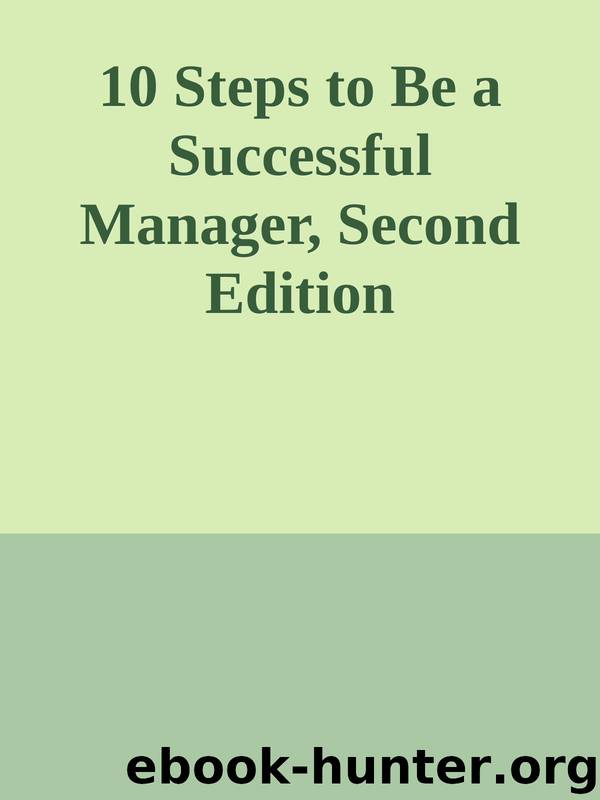10 Steps to Be a Successful Manager, Second Edition by Unknown

Author:Unknown
Language: eng
Format: epub, pdf
Is fascinating, interesting, or unique
Makes things better
Creates a strong sense of urgency for something deemed
worthy
Improves relationships
Celebrates the best in people
Expands capabilities and confidence
Offers a worthy challenge
Is fun
Did you notice that I inserted the word worthy a couple times in Exercise 5-2? That’s an important distinction. Employees love a challenge and will pull into one as long as it represents something that is worthy of their efforts. If you double their production goals, thinking it is a good challenge, well then you won’t see much in the way of pull. Similarly, pet projects that seem like a waste of time to most people won’t get much pull. Compliance, perhaps, but not pull.
You can create more pull by making small but impactful changes to the things you already do.
Let’s use the example of your next team meeting to illustrate. Example 5-1 fills in the chart from Exercise 5-2 with ideas for applying the elements that improve pull at your next staff meeting.
Did reviewing Example 5-1 give you any ideas? Try going through the exercise with other situations, such as huddles, goal setting, rounding, or training. However, I’ve got a few caveats: First, although the focus of this step is on creating pull by igniting intrinsic motivation, I am not suggesting that accountability systems (extrinsically driven) are bad. We’ll discuss
accountability in step 6. It’s another tool that produces different, but also important, outcomes.
As managers, you have many tools.
Second, creating pull is not a science— if you do X, you will not always get Y. When it comes to engagement, you are not in control. Engagement is an intrinsically driven behavior that occurs when we pull ourselves into the work. But the situation that elicits pull for me might be different than what motivates you. And it might change. There are some common triggers and conditions that tend to evoke intrinsic motivation more often, and managers who use these will see more employee engagement. And there are common elements that make the difference for many of us.
Before you plan your staff meeting, huddles, one-on-ones, rounding, or work plans, review the management practices that create pull and determine ways you can make the workplace a bit more motivating. Small actions, practiced consistently, will yield better results than twice yearly grand gestures.
EXAMPLE 5-1
MANAGEMENT PRACTICES THAT CREATE PULL IN THE WORKPLACE
Workplace Element
At the Team Meeting
Celebrates the best in
Openly acknowledge people and groups. Use the meeting as a forum to
people
share recognition.
Is fascinating, interesting,
Share a video or short article about what’s going on that’s new and
or unique
amazing in your team’s functional area.
Evokes a sense of pride
Invite someone from another department or senior leadership to share
how the team’s work affects the community. Share what the
organization does that is best in class compared with competitors.
Makes things better
Dedicate a portion of the meeting to allow team members to improve
some aspect of their work that is troublesome to them.
Creates a strong sense of
Be open about potential ramifications for work issues. Share long-term
urgency for something
goals and where the market is heading.
deemed worthy
Improves relationships
Take time
Download
10 Steps to Be a Successful Manager, Second Edition by Unknown.pdf
This site does not store any files on its server. We only index and link to content provided by other sites. Please contact the content providers to delete copyright contents if any and email us, we'll remove relevant links or contents immediately.
The Brazilian Economy since the Great Financial Crisis of 20072008 by Philip Arestis Carolina Troncoso Baltar & Daniela Magalhães Prates(105823)
International Integration of the Brazilian Economy by Elias C. Grivoyannis(75603)
The Art of Coaching by Elena Aguilar(52207)
Flexible Working by Dale Gemma;(23213)
How to Stop Living Paycheck to Paycheck by Avery Breyer(19570)
The Acquirer's Multiple: How the Billionaire Contrarians of Deep Value Beat the Market by Tobias Carlisle(12114)
Thinking, Fast and Slow by Kahneman Daniel(11803)
The Radium Girls by Kate Moore(11633)
The Art of Thinking Clearly by Rolf Dobelli(9930)
Hit Refresh by Satya Nadella(8866)
The Compound Effect by Darren Hardy(8524)
Atomic Habits: Tiny Changes, Remarkable Results by James Clear(8054)
Tools of Titans by Timothy Ferriss(7825)
Turbulence by E. J. Noyes(7717)
Change Your Questions, Change Your Life by Marilee Adams(7385)
A Court of Wings and Ruin by Sarah J. Maas(7278)
Nudge - Improving Decisions about Health, Wealth, and Happiness by Thaler Sunstein(7261)
How to Be a Bawse: A Guide to Conquering Life by Lilly Singh(7162)
Win Bigly by Scott Adams(6832)
